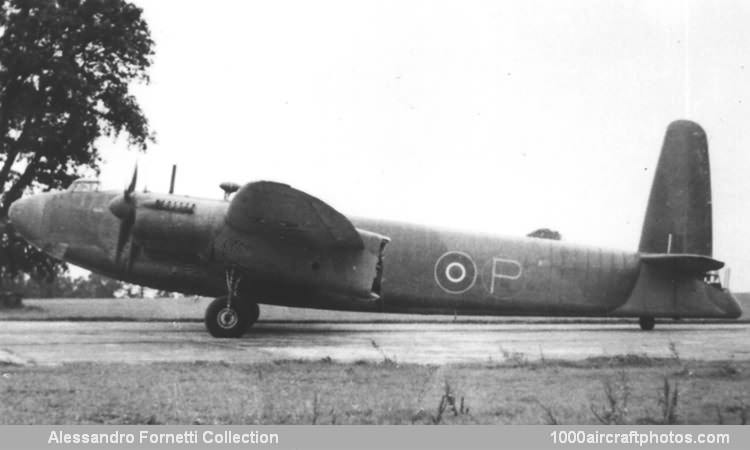08/31/2012. Remarks by Johan Visschedijk: "As one of the requirements issued during the war to cover continued bomber development, Specification B.5/41 of December 10, 1941, called for a high-altitude, heavy bomber embodying a pressure cabin for the crew and powered by four Rolls-Royce Merlins. The maximum speed was to be at least 345 mph (555 kmh) at 31,000 ft (9,449 m), the service ceiling 38,500 ft (11,735 m). with full operational load and maximum bomb load 8,000 lb (3,629 kg). A pilot, navigator/bomb-aimer, W/T operator, air gunner and observer were to form the crew of five.
R.K. Pierson of Vickers prepared a pressure-cabin development of the Warwick as the Mk.III Type 433 with high aspect ratio, elliptical wings. Design work continued on the Warwick Mk.III, leading eventually to an increase of wing span and of overall length with the object of improving the calculated performance. Four 1,600 hp Merlin 60s were selected to power the pair of B.5/41 prototypes (s/n DW506, DW512) which were subsequently ordered under contract AIR/1153/C.4(c) dated 15 July, 1941, the name Windsor being chosen for the new Vickers bomber.
In the course of the genesis of the design the provisions contained in Specification B.5/41 became obsolete in the light of continued alteration in the tactical and strategic applications of aircraft in the conflict, and in September, 1942, B.5/41 was abandoned. It was supplanted shortly by Specification B.3/42 of December 8, 1942, issued to cover DW506 and DW512, now redesignated Type 447, which were to use four 1,560 hp Merlin 61s (developed to provide a substantial output at high altitudes), and to be armed with two 0.303 in (7.7 mm) Brownings in the nose and two 0.787 in (20 mm) cannon in the tail.
During the early genesis of the first prototype, alterations took place continually in the design. Early in 1943 it was decided that DW506 should be completed with Merlin 65s using underslung radiators and that DW512 (redesignated Type 457) should have annular radiators and cowling surrounding Merlin 65s. Concurrently, the Air Ministry specified remotely controlled armament, and, after further investigation and experiment, the decision was taken to mount the guns at the rear of the outer pair of engine nacelles. While the Windsor was being constructed its radical armament system was being developed in L9704, the second prototype Warwick, which was converted to carry two 0.50 in (12.7 mm) Brownings in barbettes at the back of each nacelle with sighting carried out from the position behind the tail.
The proved and reliable system of Vickers geodetic construction was applied to the Windsor which exhibited a deep fuselage of good aerodynamic form. The finely-shaped, pointed, elliptical mainplanes were mounted at the mid-wing position, and the elliptica1 outline was applied also to the tail surfaces but with well-rounded tips. The substantial weight involved in the Windsor brought a revision of landing gear design technique, the novel expedient being adopted of four separate units, with an outer track of 50 ft (15.24 m), retracting rearwards into the nacelles.
The first Windsor, Type 447 DW506, was assembled at Farnborough, for Captain J. Summers to ease it from the runway there for the first time on October 23, 1943. Subsequently it was re-engined with Merlin 65s, but was written off some months later when it was badly damaged during a forced landing at Grove on March 2, 1944. The second Windsor, Type 457 DW512, was equipped with 1,750 hp Merlin 85s in annular cowlings and made its first flight from Wisley on February 15, 1944, piloted by Wing Commander M. Summers.
NK136, the third prototype and the last Windsor to be flown, was completed with modifications, which included stiffening of the rear portion by the use of four longerons in the fuseage (as opposed to the three embodied in DW506 and DW512) and the use of reinforced fabric covering. When first flown on July 11, 1944, NK136 was without its barbettes (the aircraft designated Type 480), but these, complete with two 0.787 in (20 mm) cannon were installed later by the spring of 1945, to give a rectangular termination to the outer nacelles, the aircraft was redesignated Type 461.
NK136 was powered by annular-cowled Merlin 85s and was used in trials with its unusual armament until early in 1946, when the entire project was abandoned on March 15. The Windsor's claim to distinction in heavy bomber evolution is that it was the ultimate expression of British concepts of piston-engine design in its class and, as such, was a worthy example with which to conclude an inspiring era of some three decades before the revolution instigated by the gas turbine."
